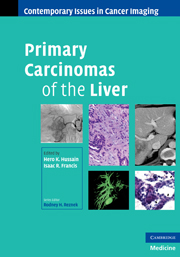Book contents
- Frontmatter
- Contents
- Contributors
- Series foreword
- Preface to Primary Carcinomas of the Liver
- 1 Epidemiology of hepatocellular carcinoma and cholangiocarcinoma
- 2 Surveillance and screening for hepatocellular carcinoma
- 3 Pathology of hepatocellular carcinoma, cholangiocarcinoma, and combined hepatocellular-cholangiocarcinoma
- 4 Radiological diagnosis of hepatocellular carcinoma
- 5 Staging of hepatocellular carcinoma
- 6 Surgical treatment of hepatocellular carcinoma: resection and transplantation
- 7 Non-surgical treatment of hepatocellular carcinoma
- 8 Radiological identification of residual and recurrent hepatocellular carcinoma
- 9 Radiological diagnosis of cholangiocarcinoma
- 10 Staging of cholangiocarcinoma
- 11 Treatment of cholangiocarcinoma
- 12 Uncommon hepatic tumors
- Index
- Color plates
- References
8 - Radiological identification of residual and recurrent hepatocellular carcinoma
Published online by Cambridge University Press: 04 August 2010
- Frontmatter
- Contents
- Contributors
- Series foreword
- Preface to Primary Carcinomas of the Liver
- 1 Epidemiology of hepatocellular carcinoma and cholangiocarcinoma
- 2 Surveillance and screening for hepatocellular carcinoma
- 3 Pathology of hepatocellular carcinoma, cholangiocarcinoma, and combined hepatocellular-cholangiocarcinoma
- 4 Radiological diagnosis of hepatocellular carcinoma
- 5 Staging of hepatocellular carcinoma
- 6 Surgical treatment of hepatocellular carcinoma: resection and transplantation
- 7 Non-surgical treatment of hepatocellular carcinoma
- 8 Radiological identification of residual and recurrent hepatocellular carcinoma
- 9 Radiological diagnosis of cholangiocarcinoma
- 10 Staging of cholangiocarcinoma
- 11 Treatment of cholangiocarcinoma
- 12 Uncommon hepatic tumors
- Index
- Color plates
- References
Summary
Minimally invasive techniques, including thermal ablation and transarterial chemoembolization (TACE), for the management of hepatocellular carcinoma (HCC) have evolved substantially over the past decade. Although surgical techniques remain the best curative option for HCC, many patients are poor surgical candidates due to severe hepatic dysfunction, comorbid conditions, or extent of tumor burden. Minimally invasive therapies are being used more frequently as an alternative primary treatment option, with either a palliative or curative intent. Critical to the management of such patients is the posttreatment imaging that is tasked with detecting residual disease and facilitating early detection of recurrent disease. This chapter discusses the computed tomography (CT) and magnetic resonance imaging (MRI) appearances of patients who have undergone minimally invasive therapy for HCC, including ablation and TACE, with an emphasis on the normal posttreatment appearance and features of residual and recurrent disease. Although both CT and MRI are used for the assessment of residual and recurrent disease, the practice in our hospital is to use MRI for postprocedural follow-up.
Background
The prompt identification of residual or recurrent disease may facilitate additional successful intervention at an early stage. Additionally, posttreatment imaging may also reveal postprocedural complications such as hepatic abscess, localized biliary ductal dilation, or biloma. Traditionally, the efficacy of treatment for cancer has been measured by criteria proposed by the World Health Organization (WHO), which use the morphological changes in a lesion's size as a marker of treatment success or failure.
- Type
- Chapter
- Information
- Primary Carcinomas of the Liver , pp. 122 - 135Publisher: Cambridge University PressPrint publication year: 2009



